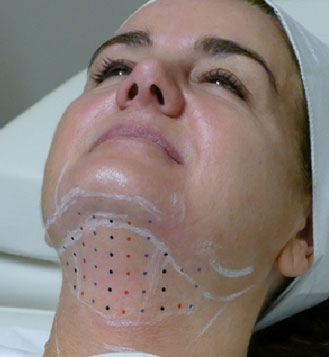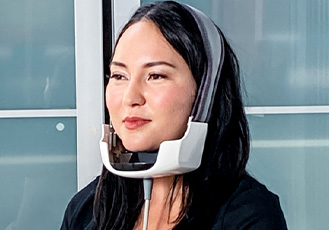
Few accomplishments are as rewarding as waking up in the morning and hitting your target weight. You've worked hard to drop those unwanted pounds all year long, and you deserve a huge round of applause for what you've accomplished. However, if you're like many men and women, getting the sleek, sculpted body you crave is easier said than done. You've got pockets of unwanted fat around your abdomen, thighs, chin, and other areas - fat that just won't go away, despite diet and exercise.
Wouldn't it be nice to just freeze that fat away and forget all about your love handles?
At Southern Cosmetic Laser, our new, revolutionary fat-freezing treatment can help you achieve the toned look you've been dreaming of. That's right - we're talking about literally freezing the unwanted fat off your problem areas without invasive surgeries or extended downtime.
This amazing treatment is called CoolSculpting, and it's the world's leading non-invasive fat reduction procedure. It's specifically designed for people already at their desired weight who want to push past that plateau for real body sculpting results. If you're tired of seeing that excess belly fat, saggy skin, or double chin, CoolSculpting is the procedure for you. Southern Cosmetic Laser offers a wide range of the newest technologies to target fat reduction, skin tightening, facial and body remodeling, body toning, and cellulite reduction.

Our Services
Services Area

What is CoolSculpting?

CoolSculpting is an FDA-approved procedure that has undeniable results. With CoolSculpting, you can permanently get rid of your muffin top, fat around your flanks, and more, all from the comfort and convenience of the Southern Cosmetic Laser office.
Technically known as cryolipolysis, CoolSculpting has the ability to reduce the number of fat cells in targeted areas between 20 and 25%. This unique technology uses controlled cooling to freeze and eliminate fat with minimal recovery time. No needles, no scalpels, no liposuction. Just real results provided by a licensed, experienced professional.
While CoolSculpting helps eliminate fat cells in your body, it doesn't harm the surrounding skin and muscles. Instead, it treats fat that is directly under the skin, also called subcutaneous fat. Since CoolSculpting doesn't target visceral fat deposits, this treatment works best for men and women who are approaching or already at their desired weight.
CoolSculpting is approved by the FDA to help reduce fat in the following areas:
- Flanks
- Outer Thighs
- Upper Arms
- Inner Thighs
- Chin
- Back
- Belly and Abdomen
How Does CoolSculpting Work?

CoolSculpting results are noticeable, proven, and long-lasting, helping you look your best and feel great from every angle. This exciting procedure works because fat cells freeze at higher temps than other tissues. As such, CoolSculpting delivers controlled, targeted cooling to do away with unwanted fat underneath your skin. These fat cells are essentially frozen or crystallized and eventually die. With time, your body will process that fat and will eliminate the dead cells, leaving behind a more sculpted physique.
Here are some quick CoolSculpting facts at a glance, so you have a better idea of why this fat cell elimination treatment is so popular:
- There is no prep time required for CoolSculpting from Southern Cosmetic Laser.
- Patients can expect some very minor discomfort during the procedure. Many patients report no discomfort at all.
- There is little-to-no downtime needed after your CoolSculpting procedure is complete.
- It may take up to 12-16 weeks to see your final results.
- This procedure eliminates fat permanently!

Southern Cosmetic Laser's CoolSculpting Procedure

Our CoolSculpting procedure is crafted around your comfort, with one-on-one attention in a relaxing atmosphere. It all starts with a detailed assessment, which you will complete prior to your treatment. This assessment will help us better understand your goals and desires, so we can freeze away the stubborn fat from the areas that matter most.
Typical CoolSculpting appointments take about an hour per area, though that time varies with each patient. Because our CoolSculpting applicators use a vacuum system to help with placement, you may feel a pulling sensation in the targeted area. Once placement is complete, we get to work on freezing your fat.
Before treatment, your skin is prepped with an alcohol wipe. A gel pad is then placed on your treatment area to help protect your skin. From there, a cold sensation is delivered through our applicators, which are designed for specific body parts.
Because there is no sedation involved with CoolSculpting, we encourage you to kick back, relax, and watch a little TV. If you prefer, you can also read or use your phone to check your favorite social media sites. Our friendly, experienced CoolSculpting technicians strive to keep you as comfy as possible during this quick treatment. When it's over, you can resume normal activities as soon as you like - there's no recovery or downtime to worry about!


Top CoolSculpting Treatment Areas

CoolSculpting procedures are perhaps best known for eliminating stubborn belly fat, giving the patient a desirable, contoured tummy. However, this treatment is also very effective on other areas of your body:
CoolSculpting for Your Double Chin
While neck fat usually goes hand-in-hand with weight gain, symptoms like double chins can appear even if you're not overweight. CoolSculpting helps solve neck fat problems by eliminating fat cells in the area below your chin, giving you a slim, youthful appearance.

CoolSculpting for Unwanted Belly Fat
Many men and women begin CoolSculpting treatments to destroy fat around the abdomen or midsection. CoolSculpting does so by freezing stubborn subcutaneous fat in the abdominal region, resulting in a trimmed-up tummy. Remember, CoolSculpting does not treat visceral fat, or the fatty tissue surrounding the organs in your abdomen.

CoolSculpting for Your Back
Back fat is a serious problem for many people in the U.S. This includes the upper back (where fat rolls over the bra), the mid-back (near the waist), and the lower back (where fat bulges over the beltline). Back fat can be hard to tone, but with CoolSculpting from Southern Cosmetic Laser in Santee, it's more than possible.

CoolSculpting for Your Upper Arms
When it comes to stubborn fat, your upper arms are often the most difficult areas to treat. If you are constantly trying to hide your upper arms from friends and family, CoolSculpting is an excellent option to help overcome your insecurity.

CoolSculpting for Your Love Handles
Sometimes called saddlebags or flanks, love handles are the flabby areas that protrude from your hips. Love handles are often caused by fat retention over long periods of time. They can appear very pronounced in tight clothing, leading to feelings of embarrassment. Common factors that contribute to love handles are age, slow metabolism, hormones, and diets high in sugars and fats. With Southern Cosmetic Laser's CoolSculpting, patients leave behind stubborn love handles, helping them achieve a slimmer, more fit appearance.

CoolSculpting for Your Thighs
If you are in good shape but suffer from chafing or discomfort due to fatty thighs, your solution could be at Southern Cosmetic Laser. Our technicians can help freeze away inner thigh fat, so you feel proud to wear skirts, shorts, and bikinis.


Questions About CoolSculpting? We've Got Answers
Q: Does CoolSculpting really work?
A: Yes! Southern Cosmetic Laser wouldn't be one of the most trusted providers of the treatment if it didn't work. According to recent statistics, CoolSculpting treatments can reduce fat reduction by as much as 25% in the affected area. Contact our office today for your initial consultation, where our team will advise you on how many treatments you need to meet your goals.
Q: How much does CoolSculpting cost?
A: Pricing varies depending on the areas you focus on and how many sessions you need in order to reach your goals. Our team will craft a custom treatment plan specific to you during your initial CoolSculpting consultation.
Q: How quickly will I see results?
A: Many patients can see results as soon as three weeks after their first CoolSculpting procedure in Santee. As your body continues to dispose of crystallized fat cells, you can see even more changes with time.
Q: Does CoolSculpting eliminate cellulite?
A: CoolSculpting is designed for fat reduction. However, it may help contribute to cellulite reduction in specific treatment areas. There are currently no FDA clearances for cellulite reduction with CoolSculpting. However, our office offers incredible treatments like Inmode Evolve to reduce the appearance of cellulite and trim, tighten, and tone your skin.
Q: Why should I choose Southern Cosmetic Laser for CoolSculpting in Santee?
A: Southern Cosmetic Laser is a CoolSculpting certified practice and has completed advanced training at the CoolSculpting University. With a highly-trained staff of medical professionals, we're one of the leading providers of CoolSculpting in South Carolina. We know that peace of mind is precious these days. That's why we're committed to you and your body contouring transformation every step of the way.
Popular Treatments That Complement CoolSculpting

We are a full-service practice offering Medical Aesthetics and Cosmetic Dermatology services. As such, Southern Cosmetic Laser has several innovative treatments that complement your CoolSculpting procedure. Whether you're looking to tighten up that turkey neck or say goodbye to cellulite, we've got a custom treatment option waiting for you.


Cellulite Treatment with Sentient Sculpt
Southern Cosmetic Laser is Santee's first medical aesthetics practice to offer Sentient Sculpt. This exciting new product reduces fat, remodels skin tissue, and regenerates skin collagen, leaving your skin tight and smooth.
Using microwave technology, Sentient Sculpt uses up to 80% of the energy generated to penetrate fat under your skin. This process destroys fat cells and the fibrous bands that cause dimples, or cellulite. The remaining 20% of energy is used on the upper layers of your skin, tightening and contracting it to improve its overall appearance.
Sentient Sculpt benefits include:
- Long-Lasting Results
- Improved Skin Laxity
- Effective Skin Tightening & Fat Reduction
- Fat Cells Permanently Destroyed
- Younger Looking Skin
- Minimal Discomfort
- Built-In Cooling for Maximum Comfort
Contact Southern Cosmetic Laser today to learn more about the benefits of Sentient Sculpt and how it can be paired with CoolSculpting treatments.

Kybella for Your Double Chin
If you're ready to kiss that double chin goodbye, Kybella could be the solution you need. Kybella is a treatment that deoxycholic acid that breaks down fat cells when injected into the treatment area. It provides noticeable results for improved chin profile.
Kybella Benefits Include:
- Permanent destruction of fat cells
- Quick treatment process
- Patients may see results in 2 to 4 treatments

Facial Remodeling with Inmode Evoke
Inmode Evoke is the first and only FDA-approved, non-invasive product for facial remodeling treatment. Evoke offers tightening and lifting for facial rejuvenation and can help you achieve a more defined neck and jawline.
The Evoke Intelligence System regulates temperature and sense impedance every millisecond, providing remarkable results. Using proven bipolar radiofrequency energy, Evoke sub-dermally remodels your facial tissue. The Evoke technology offers precise, consistent power to achieve optimal results.

Tite, Trim, & Tone with Inmode Evolve
This advanced, state-of-the-art Thermal Body Contouring Technology helps to trim, tighten, & tone your skin at the same time. Evolve's cutting-edge tech can destroy fat, reduce cellulite, and tighten skin. The result? A newfound, youthful appearance and feel. This treatment is perfect for your mommy makeover, eliminating muffin tops, sculpting abs, and addressing fat around your thighs, belly, arms, legs, hips, and knees.
Benefits of Inmode Evolve include:
- Tone and Tighten Skin
- Eliminate Fat Cells
- Reduce Crepey Skin
- Reduce Saggy Skin
- Collagen Stimulation for Improved Skin Elasticity
- Smooth Over Stubborn Fat Pockets
- Even Out and Reduce Skin Irregularities
Contact Southern Cosmetic Laser today to learn more about the benefits of Inmode Evolve and how it can be paired with CoolSculpting treatments.

Discover CoolSculpting Precision and Unlimited Beauty with Southern Cosmetic Laser
When it comes to unmatched patient care and body contouring services in Santee, no other practice comes close to Southern Cosmetic Laser. We pour passion into every service we offer, from non-surgical fat cell freezing to laser hair removal. If you're looking to make a change for the better this year, we're here to make your wishes a reality. Contact our office today to learn more about the stunning benefits of CoolSculpting technology. Before you know it, you'll be excited to show off that new bathing suit or bikini on the beach.
 843-277-2240
843-277-2240
Free Consultation
Latest News in Santee, SC
Drivers stranded for hours on I-95 after watermelon truck catches fire
wltx.comhttps://www.wltx.com/article/news/local/i-95-traffic-backup-watermelon-truck/101-28867b2a-026b-4097-8b51-d60cae36ecf0
Many drivers found themselves parked on exit ramps, while others turned around after hours of waiting.SANTEE, S.C. — Drivers traveling along Interstate 95 Wednesday morning found themselves in gridlock following a complete shutdown of the highway after a watermelon truck caught fire.Around 7 a.m. Wednesday morning, a tractor trailer caught fire, ...
Many drivers found themselves parked on exit ramps, while others turned around after hours of waiting.
SANTEE, S.C. — Drivers traveling along Interstate 95 Wednesday morning found themselves in gridlock following a complete shutdown of the highway after a watermelon truck caught fire.
Around 7 a.m. Wednesday morning, a tractor trailer caught fire, blocking all northbound lanes of I-95 near mile marker 101. That is near Lake Marion in Clarendon County. The incident caused all northbound lanes to close.
For Santee resident Henry Frazier, the shutdown brought traffic to a standstill he had never seen before.
"No, not like this, not in Santee. Man, it was rough this morning," Frazier said. "I had a dentist appointment across 95, so I parked my car about a mile and walked to the dentist because I knew I wasn’t going to make it to my appointment. So, that's where I'm at now, going to walk back to get my car. It’s been rough and really impacted us this morning."
Joe Pinto was traveling to work when he got stuck in traffic. "I've read the paper, email and Facebook, and I think I'm going to head back to Charleston and come back another day."
RELATED: Traffic again flowing on I-95 North after early morning tractor trailer fire blocked all lanes
Many drivers found themselves parked on exit ramps, while others turned around after hours of waiting.
However, Anthony Coppula and his wife, who were traveling from Florida to New York, took the gridlock in stride. "This isn't the first time, and I'm one that doesn't question why. I just go with whatever gets thrown at you and make the best of it."
Despite being stuck for hours, Coppula remained optimistic, acknowledging the long journey ahead. "It looks like we're about 13 hours or so." Thankfully, he said they were prepared.
"We always pack, I mean, but we didn't expect something like this," Coppula said. "But we packed some drinks and snacks and stuff like that that we've been munching on. But it's fine."
I-95 northbound has since re-opened.
Commentary: Opposition recklessly threatens SC energy security
Jimmy Statonhttps://www.postandcourier.com/opinion/commentary/santee-cooper-dominion-sc-natural-gas/article_504b5ae6-d0b7-11ee-9b8a-eb517bb6b8be.html
Organizations that recklessly promote an all-solar power grid at the expense of South Carolina’s energy security are at it again, firing off tweets, emails and newspaper columns employing tired scare tactics and gross distortions of reality. Their script is perhaps worthy of a cheap horror film but has no place in real conversations about South Carolina’s energy needs.Here’s the truth: South Carolina cannot meaningfully or responsibly increase solar power without adding natural gas generation.Solar panels don&...
Organizations that recklessly promote an all-solar power grid at the expense of South Carolina’s energy security are at it again, firing off tweets, emails and newspaper columns employing tired scare tactics and gross distortions of reality. Their script is perhaps worthy of a cheap horror film but has no place in real conversations about South Carolina’s energy needs.
Here’s the truth: South Carolina cannot meaningfully or responsibly increase solar power without adding natural gas generation.
Solar panels don’t produce electricity when the sun isn’t shining, but you need your air conditioner to run during thunderstorms on hot August afternoons. Battery storage is limited in duration and relies on other energy sources. It is inadequate and expensive as a backup. We need the flexibility of natural gas generation to ramp up and down according to the sun’s availability.
Saying we can do away with proven baseload generation and get by with solar, backed up only by battery storage, is a perfect way to put South Carolinians in danger. Winter Storm Elliott delivered several days of frigid temperatures and cloudy skies. Solar panels couldn’t have met power needs during the day, let alone recharged batteries to power our heat pumps at night.
Santee Cooper and Dominion Energy SC are in the early stages of planning a new, jointly built natural gas power plant that will save money and increase flexibility and reliability for customers of both utilities. This plant uses low-risk, proven technology already seen in hundreds of power plants across the country and in South Carolina. It is the most common and cheapest form of power generation available today.
We have a balanced approach that meets the energy needs of our customers, as validated by an independent consultant to the S.C. Public Service Commission. The commission approved our resource plan (with 1,020 megawatts of natural gas power and 2,100 megawatts of new solar power by 2032) as the lowest-cost, lowest-risk solution for future customer needs. Our plan also would close four coal units as new natural gas comes online, and add battery storage as technology improves and costs fall. This plan is not only the most cost-effective solution but also will significantly cut emissions.
Legislators are considering a bill that would let state-owned Santee Cooper jointly build power plants with privately owned utilities such as Dominion. The legislation also encourages Santee Cooper and Dominion to consider building a natural gas power plant at Dominion’s former generating site, Canadys.
This is important: The proposed legislation doesn’t approve the plant or allow us to bypass federal or state regulatory oversight, although the opponents want you to think it does. We will need to seek commission approval and provide full design plans, including cost projections, additional transmission needs and other details. We will need to obtain all required state and federal permits. All of these processes are public and include opportunity for your input.
In terms of environmental impact, the planned natural gas plant will affect fewer than 600 acres, most of that existing brownfield or right-of-way acreage. The Canadys site already has electric transmission access. The pipeline route options under consideration would utilize existing right-of-way to provide fuel at the site. Bringing a similar amount of solar power online would require more than 11,000 acres for the panels alone, plus additional land for transmission.
Backing up 2,100 megawatts of solar power solely with batteries would be reckless and a danger to our customers. Natural gas technology is proven and widely used. By jointly building a larger power plant than either of us would build alone, Santee Cooper and Dominion will see significant economies of scale in cost and efficiency and provide unmatched reliability for millions of South Carolinians.
It’s not just common sense. It’s the only responsible path forward.
Jimmy Staton is the president and CEO of Santee Cooper, South Carolina’s state-owned power and water utility.
Get a weekly recap of South Carolina opinion and analysis from The Post and Courier in your inbox on Monday evenings.
Clemson announces S.C. Peanut Growers Meeting
Denise Attawayhttps://news.clemson.edu/clemson-announces-s-c-peanut-growers-meeting/
Download imagePrecision agriculture, genetic improvements, sustainability and economics are just a few topics on the agenda for the 44th South Carolina Peanut Growers meeting.The meeting is slated for Jan. 25, 2024, at the Santee Conference Center, 1737 Bass Drive, Santee, South Carolina, 29142. Registration begins at 8:30 a.m. The meeting opens with a welcome from Richard Rentz, chairman of the South Carolina P...
Precision agriculture, genetic improvements, sustainability and economics are just a few topics on the agenda for the 44th South Carolina Peanut Growers meeting.
The meeting is slated for Jan. 25, 2024, at the Santee Conference Center, 1737 Bass Drive, Santee, South Carolina, 29142. Registration begins at 8:30 a.m. The meeting opens with a welcome from Richard Rentz, chairman of the South Carolina Peanut Board, at 9:40 a.m.
The morning session includes a peanut market update from Dell Cotton, manager of the Peanut Growers Cooperative Marketing Association, an update from Hugh Weathers, South Carolina commissioner of agriculture, and an economic outlook from Nathan Smith, Clemson Cooperative Extension Service economist.
Kendall Kirk, Clemson Extension precision agriculture engineer, will give an update on using precision agriculture in peanut research. Allison Randell, American Peanut Council sustainability director, will talk about The Sustainable U.S. Peanut Initiative.
The morning session ends with a presentation by Jeff Dunne, North Carolina State University peanut breeder, addressing phenotyping for genetic improvements in peanut.
Peanut yield contest awards will be announced during lunch. Prize drawings will be held immediately following lunch before the afternoon session starts. The KMC Grand Prize is a $5,000 voucher to be used towards a piece of equipment or parts – growers must visit the Kelley Manufacturing Company booth for entry and be certified as a peanut grower with an Farm Service Agency farm number.
Grand Prize from Amadas is the use of a new 4-row or 6-row Amadas Peanut Digger/Inverter for the 2024 harvest season or $10,000 towards the purchase of a new Amadas Self-Propelled Peanut Combine or $5,000 towards the purchase of a new Amadas 4-row or 6-row Pull-Type Peanut Combine. To be eligible, growers must be 2023 commercial peanut growers who intend to plant peanuts in 2024. Growers must be present to win.
Following lunch, attendees will get an update from the National Peanut Board. Dan Anco, Clemson Extension peanut specialist, will give a peanut variety and management update. The meeting will end at about 2 p.m.
Continuing education and pesticide credits will be available, as will newly updated copies of the Peanut Money-Maker 2024 Production Guide. For more information, contact Dan Anco, Clemson Extension peanut specialist at (630) 207-4926 (cell) or email, danco@clemson.edu.
-END-
Santee Cooper Strengthens Leadership with Four Appointments to Management Team
santeecooper.comhttps://www.santeecooper.com/global-news/2024/011824-Management-Changes.aspx
MONCKS CORNER, S.C. – Santee Cooper recently welcomed four new appointments to its management team – Director of Inclusive Strategies Traci J. Grant, Senior Director of Generation Carey Salisbury, General Auditor Jason McKinney and General Manager of Projects and Construction Scott Smith. These appointees will help further the company’s mission with years of valuable experience in their respective fields.Traci J. Grant has been named to a new position at Santee Cooper, Director of Inclusive Strategies, reporting to C...
MONCKS CORNER, S.C. – Santee Cooper recently welcomed four new appointments to its management team – Director of Inclusive Strategies Traci J. Grant, Senior Director of Generation Carey Salisbury, General Auditor Jason McKinney and General Manager of Projects and Construction Scott Smith. These appointees will help further the company’s mission with years of valuable experience in their respective fields.
Traci J. Grant has been named to a new position at Santee Cooper, Director of Inclusive Strategies, reporting to Chief Financial and Administration Officer Ken Lott. Grant, who will also continue in her role as Corporate Secretary, joined Santee Cooper 26 years ago as a financial analyst and has worked in the budget, customer billing, pricing and planning areas. She was named Group Leader of Pricing in May 2004 and Manager of Budget and Customer Billing in February 2017. She moved to Director of Corporate Services in March 2020. Grant has also served on Santee Cooper’s Corporate Engagement and Oversight Committee and is a recent graduate of the Diversity Leaders Initiative (DLI), an award-winning program of Furman University’s Riley Institute. She has a Bachelor of Science from South Carolina State University, where she studied agribusiness and economics.
Carey Salisbury has been named Senior Director of Generation, effective Jan. 6. Salisbury has served as Interim Senior Director of Generation since August 2023 and will continue to report to Chief Operations Officer Mike Finissi. Salisbury, a registered Professional Engineer, is a 2000 graduate of Clemson University, where he earned a Bachelor of Science in electrical engineering. He joined Santee Cooper in 2001 and has held several positions during his 23 years of service, including Engineer with Capital Projects, Maintenance Engineer, Group Supervisor of Electrical Maintenance, Superintendent of Electrical Maintenance, Manager of Renewable Generation and Manager of Cross Generating Station.
Jason McKinney was hired as General Auditor in October and reports to Chief Audit and Risk Officer Monique Washington. Prior to joining Santee Cooper, McKinney served nearly six years as the Director of Internal Audit for Lexington Medical Center in Columbia, South Carolina. He previously served 17 years as Joint Venture Audit Director at Roper Saint Francis Healthcare in Charleston. McKinney received his bachelor’s degree in accounting from the University of South Carolina Darla Moore School of Business in 1993 and his MBA in accounting and hospital administration from The Citadel in 2007.
Scott Smith joined Santee Cooper in September as the General Manager of Projects and Construction and reports to Chief Operations Officer Mike Finissi. Smith retired from American Electric Power as the Senior Vice President of AEP Transmission Field Service after more than 22 years with the utility. He also held several positions in the banking industry from 1987 to 2001, including Vice President at Citi Bank and First Fidelity. Smith enlisted in the United States Army in 1982 and completed his service as a Captain in the combat engineering field in 1994. He is a 1984 graduate of the Valley Forge Military Academy and College with a degree in finance. He also received a degree in accounting and finance from Drexel University’s LeBow College of Business in 1987.
Santee Cooper is South Carolina’s largest power provider, the ultimate source of electricity for 2 million people across the state, and one of America’s Best Midsize Employers as named by Forbes. Through its low-cost, reliable and environmentally responsible electricity and water services, and through innovative partnerships and initiatives that attract and retain industry and jobs, Santee Cooper helps power South Carolina. To learn more, visit www.santeecooper.com and follow #PoweringSC on social media.
Santee Cooper Contracts with Lowcountry Company to Replace 80-Ton Gate at the Pinopolis Lock
santeecooper.comhttps://www.santeecooper.com/global-news/2023/121323-Tainter-Gate-Replacement.aspx
MONCKS CORNER, S.C. – For just the second time in the 81-year history of Santee Cooper’s Jefferies Hydroelectric Station, the 80-ton emergency Tainter gate at the Pinopolis Lock is being replaced – with the help of a local company.Santee Cooper has partnered with W International in Goose Creek, South Carolina, to fabricate and assemble a new emergency Tainter gate for the Pinopolis Lock, which connects Lake Moultrie to the Tailrace Canal and the Cooper River. W International, located in the Bushy Park Industrial area...
MONCKS CORNER, S.C. – For just the second time in the 81-year history of Santee Cooper’s Jefferies Hydroelectric Station, the 80-ton emergency Tainter gate at the Pinopolis Lock is being replaced – with the help of a local company.
Santee Cooper has partnered with W International in Goose Creek, South Carolina, to fabricate and assemble a new emergency Tainter gate for the Pinopolis Lock, which connects Lake Moultrie to the Tailrace Canal and the Cooper River. W International, located in the Bushy Park Industrial area, is an advanced metal fabricator specializing in large, complex structural fabrications.
“Consistent with our mission, our goal is to work with businesses and industry in the state to help South Carolina thrive,” said Jimmy Staton, Santee Cooper President and CEO. “W International has a strong reputation as an industry leader in large fabrications. We’re proud to be able to say the gate was made right here in the Lowcountry and that we, as South Carolinians, are working together to energize South Carolina.”
“Working hand-in-hand with Santee Cooper on replacing the emergency Tainter gate upstream of the Pinopolis Lock system has been an extraordinary journey,” said Jim Logan, President of W International. “Our team feels honored to have contributed to such a pivotal project, particularly one located a mere 22 miles upriver from our facility – a testament to the local community.”
“Teaming up with Santee Cooper has been nothing short of inspiring,” continued Logan. “Collaborating on critical infrastructure aligns seamlessly with our shared vision of supporting Santee Cooper’s mission to enhance the quality of life for every South Carolinian. Together, we have strived to deliver not just a gate replacement, but a testament to resilience and progress for the region. We are immensely proud to have been part of this milestone achievement.”
The fully assembled Tainter gate was loaded on a barge at W International on Dec. 9 and arrived at the Pinopolis Lock after about a six-hour journey up the West Branch of the Cooper River. Crews with Superior Cranes Inc., which has a Charleston-area location in Moncks Corner, are placing the gate in its final location this week, pending any weather delays. The previous gate was damaged in September 2022 when Hurricane Ian blew through the state. The original Tainter gate, installed in 1942, reached its end-of-life stage in 2003. Those gates now reside next to each other at a permitted fish attractor location in Lake Moultrie.
The Tainter gate allows Santee Cooper to safely perform maintenance on the lock's upper miter gates. The gate also is designed to mitigate an unlikely “free flow” incident and, in the event of such an emergency, it will raise to choke off the flow of water through the lock system.
W International has delivered approximately 50 products weighing as much as 600,000 pounds via barge shipment. Their team is devoted to supporting the nation’s armed forces, and they are especially proud to contribute to U.S. Navy submarines and surface vessels.
W International SC, LLC manufactures large, close-tolerance, complex structures for critical Aerospace, Defense, and Energy projects. W International’s manufacturing facility is located in Goose Creek, South Carolina, on the Cooper River, 12 miles north of Charleston’s port, on 45 acres, with 480,000 square feet of indoor heavy manufacturing space. The facility utilizes large CNC machining centers and sophisticated welding equipment to produce highly technical, complex components.
Santee Cooper
Santee Cooper is South Carolina’s largest power provider, the ultimate source of electricity for 2 million people across the state, and one of America’s Best Midsize Employers as named by Forbes. Through its low-cost, reliable and environmentally responsible electricity and water services, and through innovative partnerships and initiatives that attract and retain industry and jobs, Santee Cooper helps power South Carolina. To learn more, visit www.santeecooper.com and follow #PoweringSC on social media.
Disclaimer:

